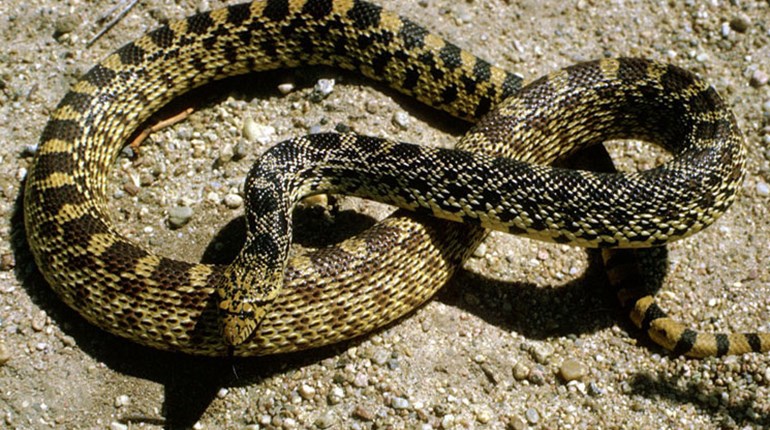
The other day I was running around a modest man-made lake near my townhouse. It’s a really nice place to get moving. The trail follows alongside the lake, runs up and down little hills, curves around trees and large rocks, puddles pocket parts of the trail, which leads to fun splashing. It’s just a really nice place to lose your train of thou-OH MY GOODNESS A SNAKE! And this is how my absent-mindedness lead me to step on an innocent snake basking in the sun. Thankfully it slithered away, but not before what I took to be the ophidian equivalent of giving me the stink-eye.
Then this got me thinking, as I continued my stroll staring intently at all sticks I passed to make sure they had no eyeballs: What should I have done had the snake not moved off the path? What are the steps I should take if I spotted one in my house? Well, I hopped on the web and found a great article by the Department of Wildlife Ecology and Conservation at the University of Florida, a state whose snake experience has been tested through and through.
First off, when encountering a snake it’s imperative to know that most snakes are not aggressive, and don’t hunt or chase humans (note: this article does not apply to interactions with giant anacondas). Secondly, be sure to keep children, younger siblings and pets away from the snake. As well, it’s good to know your state’s venomous snakes and their markings, as this will help you identify venomous versus non-venomous from a safe distance. If it’s difficult for you to judge from a safe distance, it’s best to assume it’s venomous. Along with familiarity of their markings, it’s good to know other physical signs and movements snakes will exhibit when startled or threatened. Some will flatten their heads and puff up to make themselves look larger and more intimidating. They may defensively strike, so keep your distance. They may strike offensively, so again keep your distance. Another defensive tactic of the snake is the release of an odor from glands located near their tails. The smell is musky, or skunky, and foul—an attempt to ward off predators.
The best thing to do is to let the snake be, it will be on its way quickly (snakes are known for their active social life and perfect punctuality). To help the snake move along as quickly as possible, be sure you’re not standing between them and low-lying bushes, piles of brush or leaves, a propped-up boulder or anything else that looks like a snake’s hide-a-way. This is recommended because snakes will search for cover if encountered by a possible predator (aka humans), and it’s best not to block that route.
If the snake’s calendar is empty and not moving yet you absolutely need to remove the snake from your yard, a playground, or somewhere you’re afraid someone may get bitten, call your local animal control. Take a photo and be ready to share it with them, so animal control knows what they are dealing with before arrival.
If you happen to encounter a snake indoors, be sure to keep away children, younger siblings and pets, and also keep your distance. If you are able to identify that the snake is non-venomous, attempt the bucket technique but please use extreme caution. Try taking a large and deep bucket or trash can, that has a fitted lid, and tip it on its side. Then use a long-handled broom to gently chase the snake into the bucket. Once the snake is inside your bucket, slowly tilt it upright and place the lid securely on top. Find an area away from homes and other frequented areas, and set the snake free.
If you are uncomfortable using the bucket technique above, call your local animal control or use a humane glue board snake trap. There are many commercial brands and are usually available at local hardware or department stores. Place the trap in the area the snake has been spotted in, and walk away. Be active in checking the trap frequently (at least daily) to avoid dehydration, starvation or death to the snake. Once the snake it trapped, look at its markings and try to determine if it’s venomous or not. If you are absolutely certain the snake is non-venomous, then find a secluded natural area to release the snake in and read the instructions on how to remove the snake from the glue board trap (usually vegetable oil). If you can identify the snake as being venomous, or if you are unsure, call your local animal control and inform them of your situation.
The most important information to take away from this article is that if you are unable to identify if a snake is venomous or not, it’s best to not pretend like you’re on Animal Planet, Discovery Channel or National Geographic, and call the professionals. Don’t risk a snake bite on a guess that it’s most likely non-venomous. Those professionals have tools, outerwear and experience and the know-how to remove a snake safely.
The above photo is of a bull snake, a non-venomous and helpful species that helps control vermin populations. However, they're frequently mistaken for rattlesnakes. When in doubt, keep your distance!




































